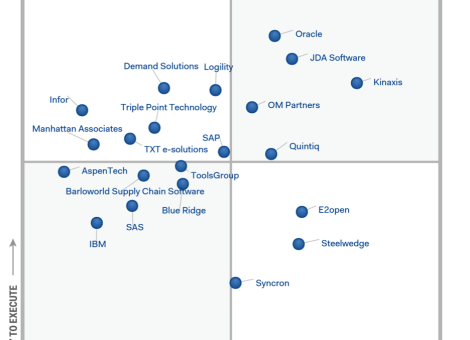Thoughts From Gartner’s 2014 Magic Quadrant
*Gartner, Inc. recently released the 2014 Magic Quadrant Report for Supply Chain Planning System of Record (SCP SOR). You can access a copy of the research here.
In addition to Gartner’s view of the competing players in the supply chain planning software market, the recently released Supply Chain Planning Magic Quadrant report includes interesting observations about the direction of the industry.
Retailers and manufacturers alike stand to gain substantially from one key observation – the movement toward more closely integrated supply chains and the use of demand-driven data to quickly respond to trends and/or disruptions.

*This graphic was published by Gartner, Inc. as part of a larger research document and should be evaluated in the context of the entire document. The Gartner document is available upon request from Blue Ridge.
According to Gartner, “In the future, the deployment of an SCP SOR will have to be increasingly in the context of multienterprise supply chains, along with the convergence of planning and execution capabilities, to facilitate more demand-driven, responsive and agile planning — especially in the short-term horizon (respond planning category) — across extended value chain.”
It is a visionary idea. Perhaps, you are not so far from seamlessly integrating the whole of your supply chain, establishing a single version of demand truth by analyzing every consumer interaction, translating precise demand needs at each supply chain tier, configuring execution plans across internal departments and with outside trading partners, all the while maintaining real-time visibility to capitalize on every emerging trend and prevent disruptions?
Ok, that’s probably a stretch; and if it is, keep reading…Retailers and suppliers, can benefit from a collaborative environment more than ever with the technology available today. And, they can do so without revamping the entire supply chain or worrying about data management woes.
As the story goes, suppliers have faced limitations in getting accurate demand signals. In some cases, the data for an accurate demand signal has not always been available; and in other cases, the capability to coordinate data from retailers and other consumer outlets has been restricted. The result is a muddled demand signal, which leads to inaccurate production data, and sub-par demand fulfillment for the retailer – not an ideal situation for either party.
There are two reasons why collaboration initiatives are much simpler and more effective today:
- There is more data available around consumer behavior than ever.
- The Cloud provides a scalable, centralized platform for data integration.
Responding to the availability of big data, game-changing technologies capitalize on the power of the Cloud to deliver actionable consumer analytics, precise demand prediction and translation of consumer demand into upstream supply chain demand.
By sharing what is known about the consumer, retailers and suppliers can establish a relationship that will increase sales and net margin for both parties:
- Suppliers gain- improved supply chain effectiveness through translation of consumer demand into upstream supply chain demand. As opposed to driving POS demand up the supply chain, proper translation gives suppliers the most accurate demand signal, enabling optimal production, operations and logistics planning.
- Retailers gain- assurance that products are available where demand will occur, more loyal and satisfied customers, plus insights into the effectiveness of promotions and other demand-driving activities.
- Both gain- The ability to measure their own effectiveness relative to their trading partners…e.g. suppliers can see how well they're fulfilling retailer's orders, and retailers can see how effective they are in penetrating the market with the supplier’s products. This opens dialogue to improve both parties’ effectiveness with the insights into the other.
While effective integration and collaboration has been seen as a daunting project for many companies, Blue Ridge and Liaison technologies have partnered to make collaborative commerce easier and more effective.
On April 10, you can join Blue Ridge and Liaison in a webinar that will explore how companies can enable collaborative commerce and use of analytics to optimize processes such as S&OP, freight management, logistics and more. We will cover data integration and harmonization, as well as real-time reporting.
The entire Gartner Supply Chain Planning Magic Quadrant report has much more information and analysis to offer- be sure to read the full report here.
*The Gartner Magic Quadrant for Supply Chain Planning System of Record was published by Tim Payne on March 06, 2014. Gartner does not endorse any vendor, product or service depicted in its research publications, and does not advise technology users to select only those vendors with the highest ratings. Gartner research publications consist of the opinions of Gartner's research organization and should not be construed as statements of fact. Gartner disclaims all warranties, expressed or implied, with respect to this research, including any warranties of merchantability or fitness for a particular purpose.


Comments are closed.